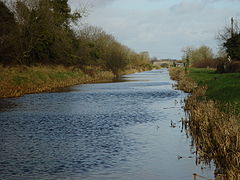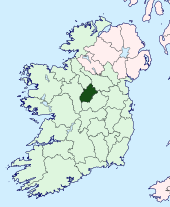County Longford
| County Longford Irish: Contae an Longfoirt Republic of Ireland | |
 The Royal Canal | |
|---|---|

| |
| [Interactive map] | |
| Province: | Leinster |
| Area: | 421 square miles |
| Population: | 39,000 |
| County seat: | Longford |
The County of Longford is a shire in the province of Leinster, Republic of Ireland. It is named after the town of Longford. The population of the county is 39,000 according to the 2011 census.

Geography
With an area of 421 square miles and a population of 38,970, Longford is the fourth smallest of the 32 counties in area and second smallest in terms of population.[1] It is also the fourth smallest of Leinster's 12 counties by size and smallest by population. It borders the counties of Cavan, Westmeath, Roscommon and Leitrim.
Towns and villages
Physical geography
Most of Longford lies in the basin of the River Shannon with Lough Ree forming much of the county's western boundary. The north-eastern part of the county, however, drains towards the River Erne and Lough Gowna. Lakeland, bogland, pastureland, and wetland typify Longford's generally low-lying landscapes: the highest point of the county is in the north-west - Carn Clonhugh (also known as Cairn Hill) at 916ft. Cairn Hill is the site of a television transmitter broadcasting to much of the Irish midlands. Longford has one of the lowest in the county peaks list ahead of Meath and Westmeath. In general, the northern third of the county is hilly, forming part of the drumlin belt stretching across the northern midlands of Ireland. The southern parts of the county are low-lying, with extensive areas of raised bogland and the land being of better quality for grazing and tillage.
History

The territory now comprising County Longford was traditionally known as Annaly (Anghaile in Irish), Tethbae or Teffia (Teabhtha in Irish) and formed the territory of the Farrell clan. After the Norman invasion of the 12th century, Annaly was granted to Hugh de Lacy as part of the Liberty of Meath. An English settlement was established at Granard, with Norman Cistercian monasteries being established at Abbeylara and Abbeyshrule, and Augustinian monasteries being established at Abbeyderg and at Saints' Island on the shore of Lough Ree. Monastic remains at Ardagh, Abbeylara, Abbeyderg, Abbeyshrule, Inchcleraun Island in Lough Ree, and Inchmore Island in Lough Gowna are reminders of the county's long Christian history.
However, by the 14th century, English influence in Ireland was on the wane. The town of Granard was sacked by Edward Bruce's army in 1315, and the O'Farrells soon recovered complete control over their former territory.
The county was officially shired in 1586 in the reign of Elizabeth I, but English control was not fully established until the aftermath of the Nine Years' War. County Longford was added to Leinster by James I in 1608 (it had previously been considered part of Connaught), with the county being divided into six baronies and its boundaries being officially defined. The county was planted by English and Scottish landowners in 1620, with much of the O'Farrell lands being confiscated and granted to new owners. The change in control was completed during the Cromwellian plantations of the 1650s.
The county was a centre of the 1798 rebellion, when the French expeditionary force led by Humbert which had landed at Killala were defeated outside the village of Ballinamuck on 8 September by a British army led by Cornwallis. Considerable reprisals were inflicted by the British on the civilian inhabitants of the county in the aftermath of the battle.
Education
There are many national and secondary schools located in the county such as Moyne Community School, St. Mels and the Convent (Longford, Granard, Ballymahon, Lanesborough).
Demographics
Longford’s population growth during the period 2002-2006 (10.6%) has been stronger than the National average (8.2%).[2]
Agriculture is an important facet in the way of life and for the economy in County Longford. There are 73,764 hectares of area (67.6% of the county's total area) farmed in the county. There are approximately 126,904 cattle in the county too.[3]
References
- ↑ Corry, Eoghan (2005). The GAA Book of Lists. Hodder Headline Ireland. pp. 186–191.
- ↑ "Demographic context" (PDF). Offaly County Council Development Plan 2009 - 2015. http://www.offaly.ie/NR/rdonlyres/A4AD027E-87E4-4353-917B-47C75D92768F/1095/Chapter2ContextandChallenges_FEB08.pdf. Retrieved 2008-06-28.
- ↑ http://www.cso.ie/studentscorner/statsfactslongford.htm
Outside links
| ("Wikimedia Commons" has material about Longford County Longford) |
- Longford Ancestry
- Farrells of Longford
- Corboy Presbyterian: County Longford's only Presbyterian Church
| Counties of the Republic of Ireland |
|---|
|
Carlow • Cavan • Clare • Cork • Donegal • Dublin • Galway • Kerry • Kildare • Kilkenny • Laois • Leitrim • Limerick • Longford • Louth • Mayo • Meath • Monaghan • Offaly • Roscommon • Sligo • Tipperary • Waterford • Westmeath • Wexford • Wicklow |
